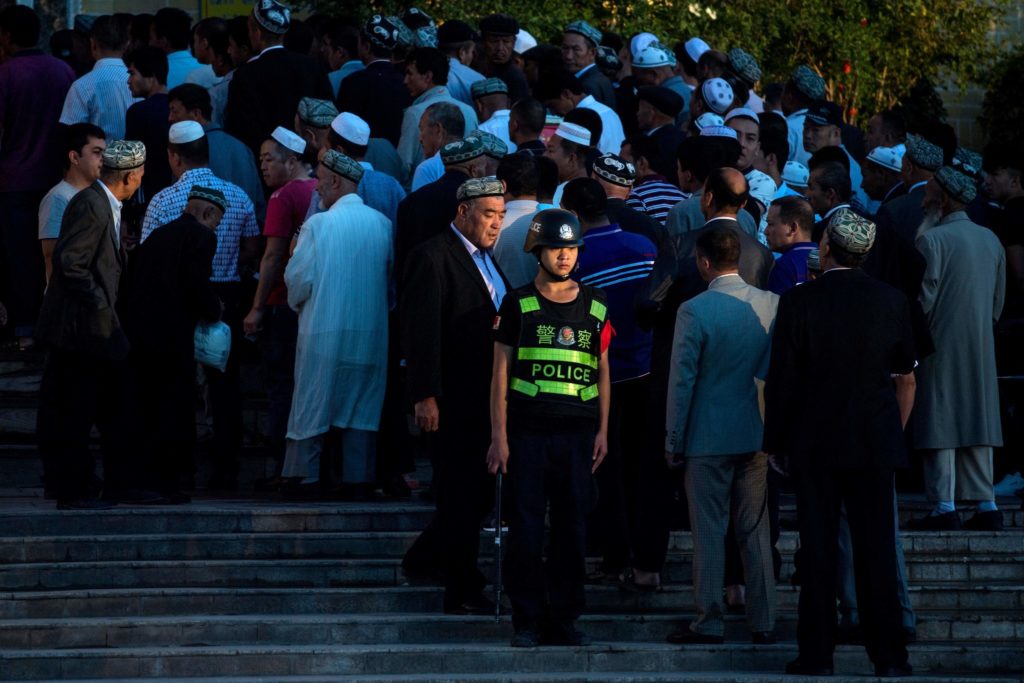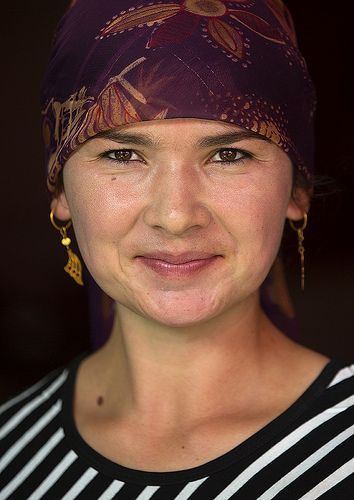HAN SELF-RIGHTEOUS RAGE IN XINJIANG
ONE of four blogposts on authoritarian China’s delusional fixation on predictive policing

Why has China coercively punished Uighurs more than Tibetans? This is a question worth exploring in depth, as some reasons are obvious, some need a lot of thought.
One answer is that Tibetans have done a lot of quiet, skilful and effective work to avert the worst. That in itself needs much consideration, in a forthcoming blog.
Both minority nationalities are routinely regarded, in the gaze of the Beijing-based security state, as chronic security threats, recidivist, stubbornly resistant to assimilation, ungrateful, uncivilised and with dangerous allegiances beyond China.
This is a regime increasingly best by enemies, wherever it looks, most of them abroad and increasingly inclined to stand up for themselves, not yield to pressure and threats. But the Tibetans and Uighurs have become China’s internal enemies, on whom China can exert maximum pressure, and then more.
Security state mentality is now embedded in popular consciousness, as well as in the elite, to such an extent that the party-state has to keep pace with the angry mob of hyper nationalist wolf warrior men whose only response is to attack, attack. The wolf warrior mentality and the authoritarian personalities revered by wolf warriors are now so strong China sees threats everywhere, aggressively alienating even those who used to be friends.

Why Xinjiang? Many answers seem relevant. Above all, China classifies the Uighurs collectively as terrorists, as it did to the Tibetans for a period after the 2008 preOlympic protests. But it is hard to call public sacrifice by burning oneself to death terrorism. The sporadic outbreaks of Uighur protest, however, were not only labelled terrorism, but also accepted as such by the security agencies of many countries willing to officially designate the Uighur resistance a terrorist organisation.
This blog explores several reasons why Xinjiang is singled out, though many apply also to Tibet. One is Xinjiang’s strategic location, as China’s land gateway to central Asia and beyond, overland to Pakistan, the Middle East and Europe, especially their resource wealth. Another factor is the scale of Han immigration into Xinjiang, in two distinct waves, populating Xinjiang with enough Han to staff the concentration camps.
A major factor, for both Tibet and Xinjiang, is the hardening of Han hearts to difference, as authoritarianism pervades the party-state from top to bottom. Seeing difference as criminal results in the securitisation of everything, making any minority assertion of difference a threat to the nation.
Another major factor is the technologies of surveillance, big data mining, and the algorithms of predictive policing, which generate the illusion that criminal acts can be predicted and thus prevented by mass detention, isolating the untrustworthy before they are even consciously aware they have criminal intent.
Xinjiang matters more to China. Tibet, as ever, is somewhat isolated by its geography, a vast island several kilometres up in the sky, hardly en route to anywhere. Xinjiang, by contrast, is China’s gateway to the whole of Eurasia and from there overland to the Middle East and Europe, the core of the Belt and Road, the oil, gas and minerals of inner Asia. Xinjiang itself is more valuable than Tibet, has had much more investment not only in infrastructure but in extraction of energy and minerals, long distance energy supply to coastal China, and is where much of the heaviest and most polluting industries have relocated. Despite China’s massive investments in infrastructure in Tibet -an area the size of western Europe, it is not on the scale of Xinjiang (yet).
These are well-recognised reasons why China’s wrath is especially intense in Xinjiang.
Tibetans are doing a lot to be acceptable to China as Buddhist insiders, while remaining insistently outsiders. The skilful ways Tibetans have eluded the worst China can punitively impose is the topic of another blog, not here.

SEDUCED BY BIG DATA
There is however one driver of the mass internment of a million or more Uighurs that is seldom noticed. This is simply that by 2015 China for the first had the technologies on hand for identifying each citizen in a population of several millions, knowing everything from each individual’s genome and blood type to a record of their habits, dress, face shape, prayers, social networks, movements; all gathered into huge integrated databases, capable of generating not only profiles but predictions as to the likelihood each and any one would behave in ways not in accord with official ideology. It was big data, and its alluring promise of predicting behaviour that by 2015 had developed sufficiently to capture the state and its surveillance apparat.[1]
2015 was the pivotal year. Prior to that big data was obviously promising. In the West, Facebook, Apple, Amazon, Netflix and Google were adept at persuading customers to generate huge amounts of data the techs could aggregate and sell, highly profitably, to advertisers mesmerised by the prospect of pitching their products to folks known to desire just what they sell. Around the world, security agencies and police forces listened attentively to the big data pitch for seamless integration of all data sources, which would result in real time tracking of crime and criminals, perhaps even sufficient data to omnisciently predict crime, and thus prevent it.
Not surprisingly, China’s security state took an interest, especially the researchers in police academies, magnetised by the emerging prospect of predictive policing, 预测警务 Yùcè jing wù. Their reports drip with references to global thought leaders pioneering these algorithmic solutions. One article, Research on Theoretical Basis and Technical Path of Predictive Policing published in Wuhan in the Journal of Hubei University of Police 湖北警官学院学报 names (in English) Jeremy Bentham, Rational Choice Theory, Deterrence Theory, crime generators, crime attractors, risk terrain, self-exciting processes, Big Data Lab, Computational Criminology, Blue CRUSH (Crime Reduction Utilizing Statistical History) and many more sources of inspiration. [Li Guojun, 李国军 Hubei University of Police, Research on Theoretical Basis and Technical Path of Predictive Policing, 预测警务的理论基础与技术路径研究, 湖北警官学院学报, Journal of Hubei University of Police, October 2016]
Predictive policing was not an idea originating in China. But, as with much else, China took it and ran with it. If Alibaba, Tencent, Baidu and others -China’s equivalents of Amazon etc.- could mine big data for spectacular profits, the security state could do it too, and attain the dream of the ideal security state in which crime is prevented before it happens.
OFFICIAL OMNISCIENCE
What became predictive policing originated in the idea that all laboriously generated data on actual crimes and criminals could be aggregated electronically, a compendium of the past of each individual under official scrutiny. For China it was only a short step to project such data forwards into the unknown future, and to categorise an entire ethnicity as criminal, hence suitable cases for treatment.
China did it because it could. China could go all out to force behaviour change in Xinjiang because official China has no qualms about arresting people who have committed no crime.
In other countries, predictive policing faces many obstacles, including technical questions about accuracy and reliability, and a moral objection that no state has the right to lock up people unless and until they actually commit a criminal act. In the West, civil liberties and freedom of expression are so entrenched as inalienable rights that societies have had the utmost trouble reining in hate speech, domestic violence and psychotic breakdowns, on the grounds that you can’t arrest anyone until they have already committed a crime.
China has no such conflicts of values, especially when it come to a minority nationality considered criminally inclined. What matters is to identify and then isolate the “extremists”, and subject them to intensive behaviour modification pressure, day and night, for long periods, until they are fully assimilated into the Chinese race-nation.

THE UIGHUR ENEMY WITHIN
That is the significance of 2015. Uighur resistance to China peaked in 2009 with street riots in the largely Han Chinese provincial capital Urumchi, with sporadic outbursts later. Xi Jinping’s 2014 tour of Xinjiang was pivotal. By 2015 there was little overt Uighur resistance anymore. Yet it was in 2015 that the security state geared up, with elaborate preparations for mass incarceration, starting with local “convenience police stations” in every neighbourhood, that took every opportunity to take blood samples and saliva swabs from everyone, to map their DNA and generate sufficient data for the algorithms to chew. The disjunct between the earlier waves of Uighur protest and the later imposition of the predictive policing state is often noticed, but seldom explained.
Another facet everyone can see, but is seldom understood, is that while one or perhaps even two million Uighurs are in secret detention and intense pressure to memorise official propaganda slogans, many more millions of Uighurs are not incarcerated.
Since China has worked hard to conceal the entire forcible assimilation campaign, no-one really knows what proportion of the entire Uighur population is imprisoned. Officially there are just over 12 million Uighurs, so roughly ten percent are incarcerated. This both a huge and a smallish proportion. The size of the internment facilities, the investment of time and money to design, build, staff and operate them is huge. The disappearance of so many people, now not seen by their families for years, is huge. Yet at the same time, predictive policing aims to be selective, weeding out those with the greatest criminal propensity, to concentrate on intensive rectification of errant tendencies, a highly labour-intensive process for gaoler and gaoled alike.
“Xinjiang’s Justice Department’s Party Committee secretary stated that in a typical (Muslim) village, 70% of the population merely ‘change with the wider surroundings’ and are hence ‘easily transformed’. In contrast, the other 30% are ‘polluted by religious extremism’. This latter group ‘requires concentrated education work…..…when the 30% are transformed…the village is basically cleansed’. In the same report, the secretary of Khotän County’s Politics and Law Committee argued that of those who received religious extremist influence, ‘about 5% belong to the hardened faction, 15% are supporters, and 80% are illiterates’.
“About 18 months later, in April 2017, the region unleashed an unprecedented re-education drive, with internment rates in Muslim-dominated regions bearing a striking semblance especially to the ratios stated by the Khotän County secretary in the mentioned report. His statements reveal the logic by which XUAR regions with a majority-Muslim population share are simply being assigned fixed internment quotas for re-education, regardless of whether those interned can in fact be convicted of any legal transgressions.”[2]

WHO IS OUR ENEMY?
China has created an industrial scale assembly line to identify the 15 to 30 per cent who require personality dismantling and remodelling as compliant Chinese citizens, speaking Chinese, with official slogans of “Xi Jinping Thought” imprinted on their minds.
By 2017 the old oasis town of Kashgar had become “a city where growing a beard can get you reported to the police. So can inviting too many people to your wedding, or naming your child Muhammad or Medina. Driving or taking a bus to a neighbouring town, you’d hit checkpoints where armed police officers might search your phone for banned apps like Facebook or Twitter, and scroll through your text messages to see if you had used any religious language. You would be particularly worried about making phone calls to friends and family abroad. Hours later, you might find police officers knocking at your door and asking questions that make you suspect they were listening in the whole time.”
If any of your surveilled behaviour triggers the algorithmic decision that you are classified as unreliable and untrustworthy, you are rounded up and put into mandatory detention, not as a preliminary to prosecution, but for “re-education.” “The instructors taught the detainees to do traditional Chinese dances in the yard of the building, she said. Sometimes there were lectures — an imam working for the state might come in and talk about how important it was to avoid “extreme” practices like wearing headscarves. Once in a while, detainees would be taken to an interrogation room to be grilled about their pasts, often for hours. “They told me I was an ‘unreliable’ person,” Ziyawudun said with another bitter laugh. Her interrogators asked her whether she had ever worn a headscarf and how long she wore her skirts. Many days, inmates were forced to sit on plastic stools beside their bunk beds, with their backs perfectly straight and their hands on their knees, watching endless state television programs extolling Chinese President Xi Jinping. Ziyawudun’s health started to deteriorate from the cold and bad food. She became anaemic. But the hospital building in the compound was even more terrifying. There, she saw men come in with bruises from being beaten and scars she thought were from electric batons. Ziyawudun’s dorm room had three cameras, which guards used to monitor the women at all times. If she were raped, she knew, there would be no one to tell about it, no place to report the crime. After all, she had landed in the camp because authorities felt she was “unreliable.” If one of the women were raped, who would believe them? She had never felt more vulnerable in her life. Sometimes at night, she said, younger women would vanish and come back with no explanations. In the darkness of the room, she would hear them quietly sobbing. “Nobody can talk about this openly,” she said. The real torture, she discovered, took place in silence, in the inmates’ minds”.
This is the lived experience of forcible assimilation, the party-state’s insistence you must adopt Chinese characteristics in all things, from dance to clothes, language, and ability to memorise and reproduce official slogans. Days, weeks, months and now years of being made to sit bolt upright and look at a screen praising the wisdom and benevolence of core leader Xi Jinping. Enemies must be rectified.

“Former detainee Tursunay Ziyawudun said she was injected until she stopped having her period, and kicked repeatedly in the lower stomach during interrogations. She now can’t have children and often doubles over in pain, bleeding from her womb, she said. Ziyawudun and the 40 other women in her “class” were forced to attend family planning lectures most Wednesdays, where films were screened about impoverished women struggling to feed many children.
“Some women have even reported forced abortions. Ziyawudun said a “teacher” at her camp told women they would face abortions if found pregnant during gynaecology exams. A woman in another class turned out to be pregnant and disappeared from the camp, she said. She added that two of her cousins who were pregnant got rid of their children on their own because they were so afraid. Another woman, Gulbahar Jelilova, confirmed that detainees in her camp were forced to abort their children. She also saw a new mother, still leaking breast milk, who did not know what had happened to her infant. And she met doctors and medical students who were detained for helping Uighurs dodge the system and give birth at home.
“In December 2017, on a visit from Kazakhstan back to China, Gulzia Mogdin was taken to a hospital after police found WhatsApp on her phone. A urine sample revealed she was two months pregnant with her third child. Officials told Mogdin she needed to get an abortion and threatened to detain her brother if she didn’t. During the procedure, medics inserted an electric vacuum into her womb and sucked her foetus out of her body. She was taken home and told to rest, as they planned to take her to a camp.”
[1] China’s Algorithms of Repression: Reverse Engineering a Xinjiang Police Mass Surveillance App, Human Rights Watch 2019
[2] Adrian Zenz (2019) ‘Thoroughly reforming them towards a healthy heart attitude’: China’s political re-education campaign in Xinjiang, Central Asian Survey, 38:1, 102-128, DOI: 10.1080/02634937.2018.1507997